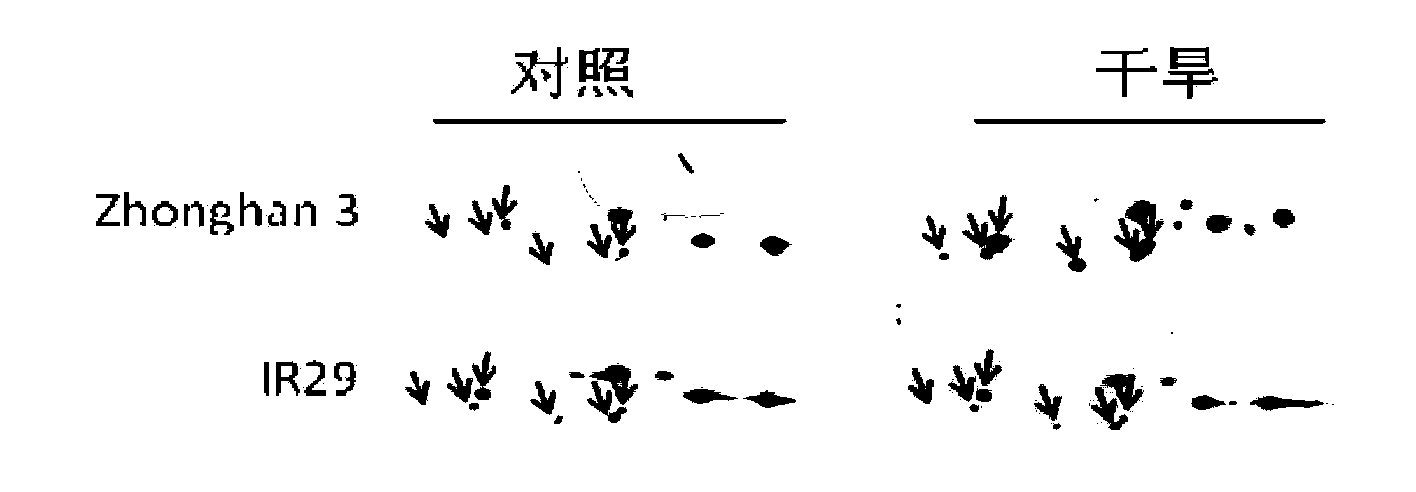Application of cytoplasm Ascorbate PeroXidase as plant drought resisting marker
A peroxidase, ascorbic acid technology, applied in the fields of biotechnology and botany, can solve long and difficult problems
- Summary
- Abstract
- Description
- Claims
- Application Information
AI Technical Summary
Problems solved by technology
Method used
Image
Examples
Embodiment 1
[0103] Embodiment 1, comparing different periods plants are affected by drought
[0104] Firstly, the effects of Zhonghan 3 and IR29 on yield under the same drought stress conditions were examined.
[0105] figure 1 A The left picture shows the water use efficiency (WUE) of the two varieties at the seedling stage, and the right picture shows the dry weight of the aboveground part (dry matter accumulation) measured after the seedlings have been cut off from water around to severe leaf curling, indicating that the two varieties are sensitive to water shortage at the seedling stage responses did not differ significantly.
[0106] However, the yield of the two varieties decreased significantly when drought stress was applied during panicle development. Such as figure 1 B, Compared with their respective plants grown under the same conditions but without drought treatment (Con), the seed setting rate of Zhonghan 3 and IR29 decreased by 39% and 68%, respectively, and the yield per...
Embodiment 2
[0108] Embodiment 2, changes in protein expression after drought treatment
[0109]During the reproductive growth period, Zhonghan 3 and IR29 were treated with water cut-off and drought, and their control (control, culture conditions were the same but without drought treatment) and drought panicle samples were taken respectively. Grinding with liquid nitrogen, lysing the sample after crude protein extraction by TCA / acetone method, and quantifying the protein by Bradford method, each took 150 μg for two-dimensional electrophoresis experiment, and the obtained two-dimensional gel was transferred to membrane and hybridized with anti-APX antibody (AS08 368, Agrisera, Sweden) , ECL chromogenic tablet. A total of 11 APX isoforms were detected by 2D-WB, of which 6 isoforms (that is, the isoforms corresponding to the positions of protein spots 1, 2, 3, 7, 8, and 9 mentioned later) were detected in Zhonghan 3 were induced by stress, while only one of these isoforms was expressed at a ...
Embodiment 3
[0117] Embodiment 3, research on the expression of APX isomers in other varieties
[0118] The above results suggest that APX has species-specificity in rice panicle response to drought stress, such as image 3 The shown APX2 (protein point 1 (molecular weight 29kD, isoelectric point 4.8), 2 (molecular weight 29.52kD, isoelectric point 4.92), 3 (molecular weight 30kD, isoelectric point 4.98)), APX1 (protein point 7 (molecular weight 26.5 kD, isoelectric point 5.15), 8 (molecular weight 27.2kD, isoelectric point 5.3), 9 (molecular weight 27.8kD, isoelectric point 5.33)). The present inventors further verified whether APX1 protein isoforms 1, 2, and 3 and APX2 protein isoforms 7, 8, and 9 can be used as drought resistance marker proteins in more rice varieties.
[0119] The typical rice Zhenshan 97B, the typical upland rice IRAT109, the relatively drought-resistant variety C22 and the drought-sensitive variety IRAT106 were treated with water cut-off and drought during the repro...
PUM
 Login to View More
Login to View More Abstract
Description
Claims
Application Information
 Login to View More
Login to View More - R&D
- Intellectual Property
- Life Sciences
- Materials
- Tech Scout
- Unparalleled Data Quality
- Higher Quality Content
- 60% Fewer Hallucinations
Browse by: Latest US Patents, China's latest patents, Technical Efficacy Thesaurus, Application Domain, Technology Topic, Popular Technical Reports.
© 2025 PatSnap. All rights reserved.Legal|Privacy policy|Modern Slavery Act Transparency Statement|Sitemap|About US| Contact US: help@patsnap.com



